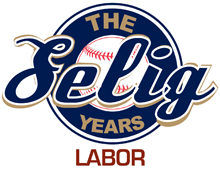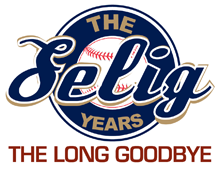1934
■ Allan H. “Bud” Selig born July 30 in Milwaukee.
1956
■ Earns a bachelor’s degree in American history and political science from the University of Wisconsin-Madison.
1970
■ Leads a group that buys the Seattle Pilots out of bankruptcy to become the Milwaukee Brewers.
1982
■ Brewers appear in the World Series, losing to the St. Louis Cardinals in seven games.
1992
■ On Sept. 9, two days after leading a movement to oust Commissioner Fay Vincent, Selig is named chairman of MLB’s executive council, making him interim commissioner.
1998
■ After serving as interim commissioner for six years, Selig is elected the ninth commissioner by a unanimous vote of the 30 MLB club owners. Selig transfers his ownership stake in the Brewers to a blind trust, and his daughter Wendy becomes president and CEO of the team.
2005
■ The Selig family sells the Brewers to Mark Attanasio.
2010
■ Statue of Selig unveiled outside of Miller Park.
The number of teams, divisions and playoff games increased under Selig’s watch.
1994
■ Oversees realignment into three divisions for each league. One wild-card team from each league is added to the playoff format. The strike by players cancels the end of the 1994 season, so the new wild-card system is not implemented until the following year.
1995
■ Selig’s expansion committee recommends expanding by four teams. Tampa-St. Petersburg, Phoenix, Orlando and two separate groups from Northern Virginia are the finalists, pledging expansion fees estimated at $125 million to $140 million.
1997
■ Moves the Milwaukee Brewers from the American League to the National League. Selig is still majority owner of the team at this time.
1998
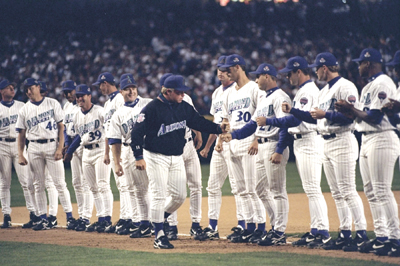 |
The Arizona Diamondbacks gather prior to Opening Day in 1998, their first season in the league.
Photo by: Getty Images |
■ Arizona and Tampa Bay begin play as the 29th and 30th MLB teams.
2001
■ Owners vote to approve contraction, widely reported to be the Montreal Expos and Minnesota Twins. On Dec. 6, Selig tells the House Judiciary Committee that MLB lost more than $500 million in 2001 alone. The players union disputes the figures, as well as the need for contraction.
■ Owners vote unanimously to extend Selig’s contract through 2006.
2002
■ Owners approve Selig’s three-team swap in which then-Expos owner Jeffrey Loria sells the team to the new MLB-owned Expos Baseball LP for $120 million. Loria then buys the Florida Marlins from John Henry for $158.5 million, with MLB lending Loria the $38.5 million difference. Henry subsequently becomes controlling owner of the group that buys the Boston Red Sox for $700 million.
■ Selig declares that no teams will be eliminated in 2002, but vows that two teams will be shuttered before the 2003 season.
2004
■ On the day of Montreal’s last home game of the season, MLB announces that the Expos will relocate to Washington, D.C.
2006
■ Selig selects a group led by Washington, D.C.-based real estate developer Ted Lerner as the new owner of the Washington Nationals. The purchase price is $450 million.
2013
■ The Houston Astros move from the National League to the American League.
During Selig’s tenure, 20 new ballparks opened and more than $10.5 billion in stadium construction took place. Each stadium’s approval (or denial) process came with its own story.
Minneapolis, 1995-2010
■ For a dozen years, the Minnesota Twins have several seemingly finalized stadium plans scuttled before officially breaking ground in 2007 on what would be called Target Field.
Miami, 1999-2012
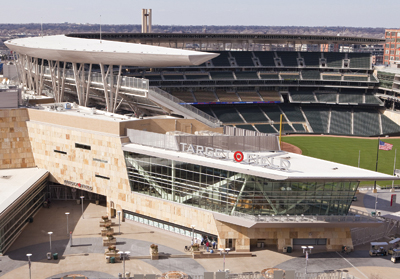 |
Target Field in Minneapolis is shown prior to the start of the its debut season in 2010.
Photo by: Getty Images |
■ Immediately after buying the Florida Marlins, new owner John Henry begins to lobby for a new retractable-roof stadium. After the Marlins win a second World Series title in 2003, owner Jeffrey Loria threatens to move the team and begins openly talking with other cities. A 2008 ballpark deal falls through, but a renegotiated deal is struck a year later, and Marlins Park opens in 2012.
Bay Area, 1995-present
■ San Jose, Las Vegas and Santa Clara each appears on the radar at some point from 1995-2001, as then-owner Steve Schott looks for ways to move the A’s out of Oakland. In 2001, the city of Oakland and Alameda County hire architects HOK to study ballpark locations in Oakland and other Alameda County cities. Lew Wolff buys the club in 2003, and after three years of politicking, he, Selig and Cisco CEO John Chambers hold a news conference to announce that the A’s would build a new ballpark, called Cisco Field, in Fremont, Calif. Wolff says the team would be called the “San Jose A’s of Fremont” or “Silicon Valley A’s of Fremont.” However, territorial disputes from the San Francisco Giants keep the proposal from becoming reality.
Tampa-St. Petersburg, 2007-present
■ The design of a waterfront ballpark for the Rays is released in 2007, but the plan dies two years later. In 2010, Rays owner Stuart Sternberg announces that he needs to explore stadium options outside of St. Petersburg. In January 2013, he says he wants to keep his team in the region, but “MLB at this point no longer believes in the Tampa Bay area.”
Since the 232-day player strike ended just before 1995 Opening Day, MLB and the MLB Players Association have successfully implemented new labor agreements without a strike or lockout in 1997, 2003, 2007 and 2012.
1994
■ “He is a very successful automobile dealer. What makes him think he has the abilities to do what he is attempting to do here is beyond my comprehension.” — Baltimore Orioles owner Peter Angelos on Selig and the lockout negotiations
■ “It doesn’t matter what we do. You’re going to get rid of Selig and [lead counsel Richard] Ravitch, get a new negotiating team and you’re going to cave in.” — Los Angeles Dodgers player representative Orel Hershiser, to owners in the final negotiating sessions before players go on strike.
■ Players go on strike on Aug. 12, forcing Selig to cancel the rest of the season and the World Series.
 |
Fans protest in 1994 on the eve of the players' strike.
Photo by: Getty Images |
1995
■ As replacement players take the field in spring training, the National Labor Relations Board cites the owners for unfair labor practices and files for an injunction to return the players to work under terms of the expired collective-bargaining agreement. Eventual Supreme Court Justice Sonia Sotomayor issues a preliminary injunction against the owners, and the strike ends three days later. The 232-day ordeal remains the longest players strike in U.S. sports history.
■ Baseball’s owners in May end their 120-day lockout of the umpires union, reaching a five-year agreement that enables the regular umpires to return to work with raises ranging from 25 percent to 37.5 percent.
1999
■ Longtime umpire Richie Phillips becomes general counsel and executive director of the Major League Umpires Association and advocates a strategy of mass resignations. Selig shocks them by accepting most of the resignations, terminating their employment and promoting replacement umpires from the minor leagues. The umpires, led by John Hirschbeck, vote to decertify the union, and replace it with the World Umpires Association.
■ Following the 1999 season, the American and National leagues are merged with MLB, and the leagues cease to exist as business entities. The positions of the league presidencies, held by Gene Budig (American League), and Leonard Coleman (National League), respectively, are abolished.
2001
■ “I have a hard time believing it, Mr. Selig, that they’re [team owners] losing that kind of money and still paying the salaries they’re paying. That’s asinine. These people did not get the wealth that they have by being stupid.” — Minnesota Gov. Jesse Ventura, on Selig’s plan to eliminate two baseball teams. Selig had repeatedly told the House Judiciary Committee that his sport’s financial problems were caused by a “system that is badly flawed.”
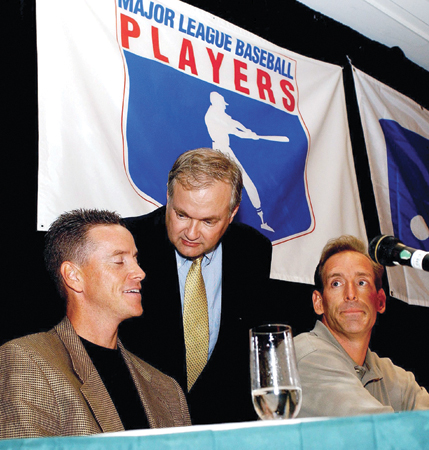 |
The Atlanta Braves' Tom Glavine (left) and B.J. Surhoff (right) join Don Fehr, then the MLBPA's executive director, to announce the 2002 labor deal.
Photo by: Getty Images |
2002
■ Selig asks the players union to accept a luxury tax that would slow the increase of salaries. He also proposes that teams vastly increase the amount of local revenue they share.
■ In August, the league and MLBPA reach a new collective-bargaining agreement. The agreement, effective starting with the 2003 season, includes increased revenue sharing, a tax on high payrolls, tighter debt rules, and steroid testing. It guarantees that no team will be eliminated by contraction through 2006.
2009
■ Umpires reach a five-year labor agreement, which is reportedly the largest such contract in the history of MLB. The contract runs through December 2014.
2014
■ In his final labor negotiation before retiring, Selig approves a five-year umpire deal just days before the existing agreement is set to expire.
1991
■ Then-Commissioner Fay Vincent sends a memo to all clubs outlining the ban of “all illegal drugs and controlled substances, including steroids.” However, no testing policy is collectively bargained with the players union.
1995
■ Selig tells the Los Angeles Times that the topic of steroid use was addressed in an owners meeting a year or 18 months prior. “If baseball has a problem, I must say candidly that we are not aware of it. It certainly hasn’t been talked about much. But should we concern ourselves as an industry? I don’t know. Maybe it’s time to bring it up again.”
1998
■ St. Louis Cardinals slugger Mark McGwire, at the time on his way to breaking Roger Maris’ single-season home run record, acknowledges taking andro, an over-the-counter pill, for the past year. Andro is banned at the time by the NFL, International Olympic Committee and NCAA.
2002
■ MLB signs a new labor agreement that, for the first time, will include testing for performance-enhancing drugs. The tests were to be anonymous and would carry no punishments.
2003
■ Local and federal agents raid the Bay Area Laboratory Co-Operative, which counts elite track and field athletes and Barry Bonds as clients.
■ MLB and the players union report that 5 to 7 percent of players tested positive for steroids in random testing during the year; as a result, more random testing will occur in 2004, with a second positive test resulting in a 15-day suspension.
■ Bonds, Jason Giambi, Gary Sheffield and others testify before a grand jury hearing evidence about BALCO.
2005
■ MLB players and owners reach a new drug-testing agreement calling for more banned substances and a 10-day penalty for first-time offenders. By the end of the year, players and owners agree to Selig’s suggested plan to suspend first-time steroid offenders for 50 games, a 100-game ban for second offenders and a lifetime ban for a third violation. The policy also provides for more frequent tests for amphetamines and shifts administration of testing to an independent person.
■ Jose Canseco’s book, “Juiced,” is released, in which Canseco alleges steroid use by McGwire, former Texas Rangers teammates Ivan Rodriguez, Juan Gonzalez and Rafael Palmeiro, as well as other players.
■ Selig, McGwire and Palmeiro are among those testifying before the House Committee on Government Reform, which is examining steroid use in baseball. When asked about whether he used steroids, McGwire repeatedly says he’s “not here to talk about the past.” Palmeiro, pointing a finger for emphasis, says “I have never used steroids. Period. I don’t know how to say it any more clearly than that.” Later that year, Palmeiro tests positive for steroids.
2006
■ Selig announces that George Mitchell, the former U.S. Senate majority leader, will lead an investigation into performance-enhancing drug use in baseball. The move comes after “Game of Shadows,” a book by San Francisco Chronicle reporters Mark Fainaru-Wada and Lance Williams, is released, detailing Bonds’ alleged use of performance-enhancing drugs.
2007
■ Bonds is indicted on four counts of perjury and one count of obstruction of justice in his testimony to the BALCO
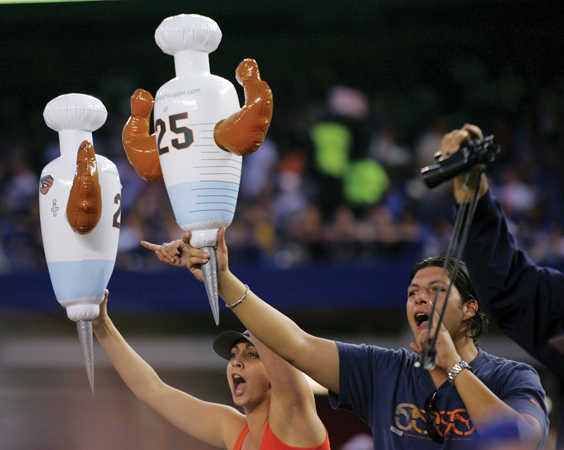 |
Fans taunt Barry Bonds in 2007.
Photo by: Getty Images |
grand jury. Bonds eventually is convicted of only the obstruction charge.
■ Following a seven-month investigation by the Albany (N.Y.) County District Attorney’s office of an Orlando-based pharmacy called Signature Pharmacy, MLB announces 15-day suspensions for Jay Gibbons and Jose Guillen.
■ Mitchell releases a report indicating widespread use of performance-enhancing drugs in MLB. Among the names tarnished were those of Roger Clemens, Miguel Tejada, Andy Pettitte and Eric Gagne. Pettitte admits three days later to using HGH in 2002.
2012
■ Melky Cabrera, then of the San Francisco Giants, is named MVP of the MLB All-Star Game in Kansas City. Within weeks Cabrera, Bartolo Colon, then of the Oakland A’s, and the Padres’ Yasmani Grandal are each suspended 50 games after tests reveal elevated levels of testosterone. Their names each appear in records of Miami-based Biogenesis.
2013
■ The Brewers’ Ryan Braun accepts a 65-game suspension.
■ MLB announced the suspensions of the Yankees’ Alex Rodriguez and a number of other players. A-Rod is suspended for 211 games, a penalty later reduced to 162 on appeal.
2014
■ Biogenesis owner Tony Bosch and associates are picked up by DEA agents and charged in “Operation Strikeout.” Several people associated with Biogenesis have already been sentenced, with Bosch’s sentencing scheduled for Feb. 17.
MLB’s national media presence went from sporadic and often dysfunctional to stable and lucrative under Selig. Its average annual media rights revenue increased more than 350 percent since 1996.
1994
■ On July 12, Selig’s first media deal begins when The Baseball Network kicks off its coverage with the All-Star Game out of Pittsburgh’s Three Rivers Stadium. The game was televised on NBC with Bob Costas. The Baseball Network was a joint venture between ABC, NBC and MLB, in which the league produced its own in-house telecasts of games, which were then brokered to air on ABC and NBC.
2004
■ MLB executive vice president of business Tim Brosnan briefs owners on the league’s TV deals, talks that include a proposed MLB channel.
2009
■ With Selig calling it the “ultimate television destination for baseball,” MLB Network goes on the air with an estimated reach of 50 million households.
Media rights deals under Selig
■ 1996-2000: Fox, NBC and ESPN combine to pay $1.7 billion for media rights.
■ 2000-05: ESPN pays $851 million.
■ 2001-06: Fox pays $2.5 billion.
■ 2007-13: Fox, Turner and ESPN combine to pay $5.21 billion for media rights.
■ 2014-21: Fox, Turner and ESPN will combine to pay $12.4 billion for media rights.
1996
■ The first regular-season MLB games are played outside of the United States and Canada, as the New York Mets and San Diego Padres play a three-game series in Monterrey, Mexico.
■ MLB opens an office in London.
1998
■ MLB opens an office in Australia.
1999
■ Fidel Castro, Selig and Peter Angelos attend a Baltimore Orioles-Cuban National Team exhibition game in Cuba. Jose Contreras, the ace of the Cuban pitching staff, dominates the game and would defect to the U.S. three years later.
2000
■ MLB opens an office in the Dominican Republic.
2004
■ MLB opens an office in Japan.
2006
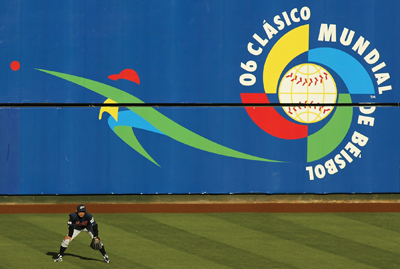 |
The World Baseball Classic makes its debut in 2006.
Photo by: Getty Images |
■ First World Baseball Classic is played. Two subsequent tournaments have been staged, with a total of 18 countries participating.
2008
■ MLB opens an office in China.
2009
■ MLB launches the Australian Baseball League.
2014
■ The Arizona Diamondbacks and Los Angeles Dodgers play MLB’s Opening Series at the historic Sydney (Australia) Cricket Ground. MLB has previously opened seasons in Monterrey, Mexico (1999); Tokyo (2000, 2004, 2008, 2012); and San Juan, Puerto Rico (2001).
Selig’s retirement will end his tenure as commissioner after more than 22 years, the second longest in baseball history.
1998
■ Accepts a five-year term.
2001
■ Owners extend his contract through 2006.
2003
■ Tells a group of sports editors that he will not seek a new term when his contract expires Dec. 31, 2006. “When I took the job, I told my wife I’d do it for two to three months, and it has turned into 14 years. There are some other things I want to do.”
2004
■ Says he will not retire in 2006 as planned and will retire instead after a new three-year term ends in 2009.
2008
■ Accepts a three-year extension that carries him past his supposed retirement date of the end of 2009. Says Selig: “This is clearly it. I can say this without equivocation.”
2010
■ Accepts an extension through the 2014 season.
2013
■ Formally declares his plans to retire when his current contract ends on Jan. 24, 2015.
Source: SportsBusiness Journal research







